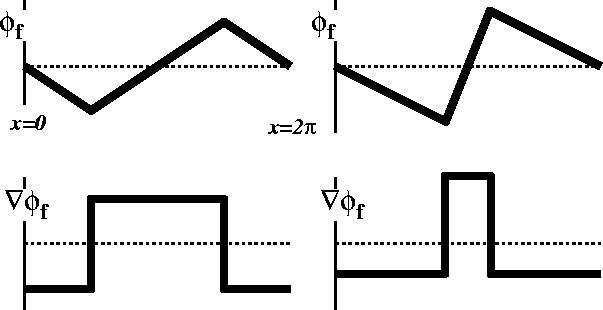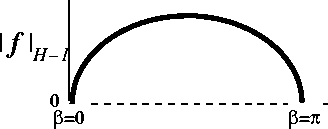The same properties for norms and inner products on vectors apply to norms on fields. What does the magnitude of a function mean? What does it mean for a function to be near zero?
There are an infinite number of inner products and norms on fields.
A common choice is to sum the point-wise multiplication of two fields over
a domain ![]() :
:
this is the definition of the ![]() inner product and norm
(functions defined
on a domain with an inner product make up a Hilbert space).
The
inner product and norm
(functions defined
on a domain with an inner product make up a Hilbert space).
The ![]() norm is what is minimized in a parametric least squares fit of a
function to data.
If f and g have integral zero (which can be produced by subtracting of
their averages),
then the norm is a measure of `how far the function is from zero.' For the
rest of this section, all functions assumed to have integral zero.
norm is what is minimized in a parametric least squares fit of a
function to data.
If f and g have integral zero (which can be produced by subtracting of
their averages),
then the norm is a measure of `how far the function is from zero.' For the
rest of this section, all functions assumed to have integral zero.
However, our notion of the distance of a function from zero
may depend on the physical context.
For example, consider the function defined on the periodic domain ![]() :
:
which is plotted in figure 2.1

* Figure ![]() .
. ![]()
With the ![]() norm,
norm, ![]() is independent of
is independent of ![]() in
Fig. 2.1; this is reasonable
if ``stuff'' need not flow from one bump to another.
However, if flow is required then the
in
Fig. 2.1; this is reasonable
if ``stuff'' need not flow from one bump to another.
However, if flow is required then the ![]() norm is not a useful measure of
the
distance of the function from zero.
norm is not a useful measure of
the
distance of the function from zero.
The ![]() (called `H minus one') norm is
particularly useful for diffusive type processes in which there is a
conservation law.
(called `H minus one') norm is
particularly useful for diffusive type processes in which there is a
conservation law.
![]()
where ![]() is the solution to the Poisson PDE:
is the solution to the Poisson PDE:
![]() .
As a result the set of functions in
.
As a result the set of functions in ![]() inner products is limited to
those with integral 0, and thus
inner products is limited to
those with integral 0, and thus ![]() is a prime candidate for
variables that are conserved.
It may be helpful to visualize
is a prime candidate for
variables that are conserved.
It may be helpful to visualize ![]() as the steady state
concentration
profile for a mass source density given by
as the steady state
concentration
profile for a mass source density given by ![]() ; then the
; then the
![]() norm is the
norm is the ![]() norm of the flux density
norm of the flux density .
.
The natural inner product for ![]() is:
is:
We examine how the inner product behaves on the functions
defined in Figure 2.1, by integrating the
function twice to get ![]() :
:

* Figure ![]() .
. ![]()
![]() and
and ![]() for the two
functions in Figure 2.1 in the limit of small
for the two
functions in Figure 2.1 in the limit of small ![]() .
.
If the ![]() norm of f is now plotted as a function of
norm of f is now plotted as a function of ![]() in the limit of
small
in the limit of
small ![]() , we get Figure 2.3.
, we get Figure 2.3.

* Figure ![]() .
. ![]()
![]() norm of the function in Figure
2.1
as a function of the bump separation in the limit of small
norm of the function in Figure
2.1
as a function of the bump separation in the limit of small ![]() :
:
![]() .
This illustrates how the magnitude of the function
increases with how much the system must diffuse to reach a uniform
value.
.
This illustrates how the magnitude of the function
increases with how much the system must diffuse to reach a uniform
value.
The ![]() inner product can be written in a more convenient form, by noting
that
inner product can be written in a more convenient form, by noting
that
![]() and using the divergence theorem:
and using the divergence theorem:
where the integral at the boundary is
assumed to be zero
and the operator
![]() is the `inverse Laplacian.' The last form is directly
usable for finding the gradient flow for f.
is the `inverse Laplacian.' The last form is directly
usable for finding the gradient flow for f.
To see how the inner product is related to the functional norm,
let F be the total free energy of a system with a
free energy density which can be written a function of position, concentration
and concentration
gradients,
![]() at time t=0:
at time t=0: ![]() .
With a flow field,
.
With a flow field, ![]() , the total free energy as a function of time is
approximately
F(f + vt)
for small t>0.
The initial rate of change of F is:
, the total free energy as a function of time is
approximately
F(f + vt)
for small t>0.
The initial rate of change of F is:
where ![]() is the variational derivative of F-the
left-hand-side of Euler's
Equation from variational calculus[5]
from using the divergence theorem to remove derivatives
of v in the volume integral,
assuming the boundary integral is zero
is the variational derivative of F-the
left-hand-side of Euler's
Equation from variational calculus[5]
from using the divergence theorem to remove derivatives
of v in the volume integral,
assuming the boundary integral is zero .
Again,
.
Again, ![]() will depend on the choice of the inner product.
The integral over the boundary
will depend on the choice of the inner product.
The integral over the boundary ![]() usually vanishes identically, either because admissible
flows v vanish on
usually vanishes identically, either because admissible
flows v vanish on ![]() (Dirichlet conditions), or
because the function g, which depends on derivatives of f with
respect to its gradient and higher order-derivatives, vanishes (Neumann
conditions).
(Dirichlet conditions), or
because the function g, which depends on derivatives of f with
respect to its gradient and higher order-derivatives, vanishes (Neumann
conditions).
Since the inner product depends on the rate of change, it is natural to
locally `weight' these inner products with some
constant or function ![]() representing the mobility.
For example in
representing the mobility.
For example in ![]() mobility weighting,
a function with a `bump' in a region of high mobility
is closer to zero than it would be if the bump is a region
of low mobility.
Thus the
mobility weighting,
a function with a `bump' in a region of high mobility
is closer to zero than it would be if the bump is a region
of low mobility.
Thus the ![]() inner product is usually modified to
inner product is usually modified to
![]()
and the ![]() inner product modified to
inner product modified to
![]()
We now show how standard evolutions result from doing gradient flows with these inner products.